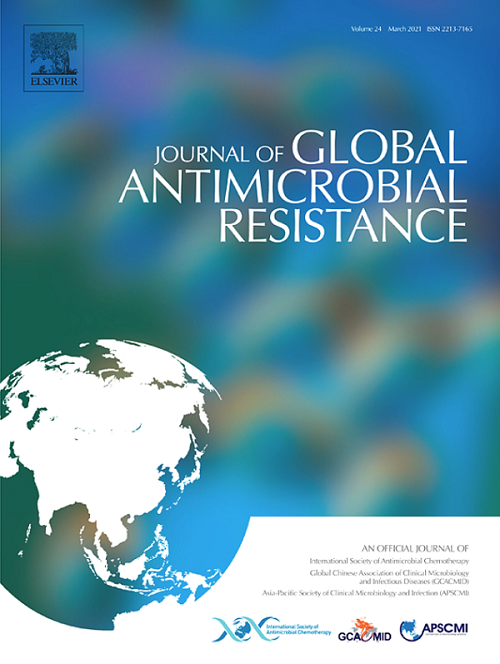蒙特卡洛模拟用于优化重症患者因产碳青霉烯酶肺炎克雷伯氏菌继发血流感染的最佳治疗剂量。
IF 3.7
3区 医学
Q2 INFECTIOUS DISEASES
引用次数: 0
摘要
研究目的我们旨在基于药代动力学/药效学(PK/PD)目标,使用蒙特卡洛模拟来研究和确定重症患者中耐碳青霉烯类肺炎克雷伯氏菌(CRKP)的现有联合疗法的最佳剂量:我们收集了2020年10月至2022年6月期间来自Phramongkutklao医院的CRKP临床分离株。使用聚合酶链反应(PCR)对耐药基因进行了分子研究。使用肉汤微量稀释核对板评估单一和协同抗生素活性。根据达到目标的概率(PTA)和累积反应分数(CFR),采用蒙特卡洛模拟确定最佳抗生素方案:结果:54 个 CRKP 分离物对替加环素(100%)、可乐定(75.9%)、阿米卡星(70.4%)和庆大霉素(63.0%)耐药。最常见的碳青霉烯酶基因型是类 blaoxacillinases (OXA)-48(42.6%),其次是 blaNew Delhi metallo beta lactamase (NDM)(29.6%),以及 blaOXA-48-like 和 blaNDM 共存(22.2%)。根据 PTA,观察到适当剂量的替加环素-科利司汀(67.9%)、替加环素-庆大霉素(62.2%)和替加环素-阿米卡星(51.4%)对 CRKP 分离物具有协同和相加活性:对于 CRKP 重症患者,尤其是 NDM 患者,替加环素-科利司汀是目前最佳的联合疗法。与替加环素联合使用时,可乐定肌酐清除率(CrCl)本文章由计算机程序翻译,如有差异,请以英文原文为准。
Monte Carlo simulation for dosage optimization of the best available therapy for bloodstream infections secondary to carbapenemase-producing Klebsiella pneumoniae in critically ill patients
Objective
We aimed to use Monte Carlo simulation, based on pharmacokinetic/pharmacodynamic targets, to investigate and determine the optimal dosage of the available combination therapies for carbapenem-resistant Klebsiella pneumoniae (CRKP) in critically ill patients.
Methods
We collected CRKP clinical isolates from Phramongkutklao Hospital between October 2020 and June 2022. A molecular study of resistant genes was performed using polymerase chain reaction. Broth microdilution checkerboards were used to evaluate the mono- and synergistic antibiotic activities. Monte Carlo simulation was used to determine the optimal antibiotic regimens, based on the probability of target attainment (PTA) and cumulative fraction of response.
Results
The 54 CRKP isolates were resistant to tigecycline (100%), colistin (75.9%), amikacin (70.4%), and gentamicin (63.0%). The most common carbapenemase genotype was blaoxacillinases (OXA)-48-like (42.6%), followed by blaNew Delhi metallo beta-lactamase (NDM) (29.6%) and coexistence of blaOXA-48-like and blaNDM (22.2%). Based on the PTA, synergistic and additive activities against CRKP isolates were observed with appropriate dosages of tigecycline–colistin (67.9%), tigecycline–gentamicin (62.2%), and tigecycline–amikacin (51.4%).
Conclusions
Tigecycline–colistin was the best available combination therapy for critically ill patients with CRKP, especially NDM. When used in combination with tigecycline, a colistin creatinine clearance of <90 mL/min can raise the cumulative fraction of response target and less nephrotoxicity.
求助全文
通过发布文献求助,成功后即可免费获取论文全文。
去求助
来源期刊

Journal of global antimicrobial resistance
INFECTIOUS DISEASES-PHARMACOLOGY & PHARMACY
CiteScore
8.70
自引率
2.20%
发文量
285
审稿时长
34 weeks
期刊介绍:
The Journal of Global Antimicrobial Resistance (JGAR) is a quarterly online journal run by an international Editorial Board that focuses on the global spread of antibiotic-resistant microbes.
JGAR is a dedicated journal for all professionals working in research, health care, the environment and animal infection control, aiming to track the resistance threat worldwide and provides a single voice devoted to antimicrobial resistance (AMR).
Featuring peer-reviewed and up to date research articles, reviews, short notes and hot topics JGAR covers the key topics related to antibacterial, antiviral, antifungal and antiparasitic resistance.
 求助内容:
求助内容: 应助结果提醒方式:
应助结果提醒方式:


